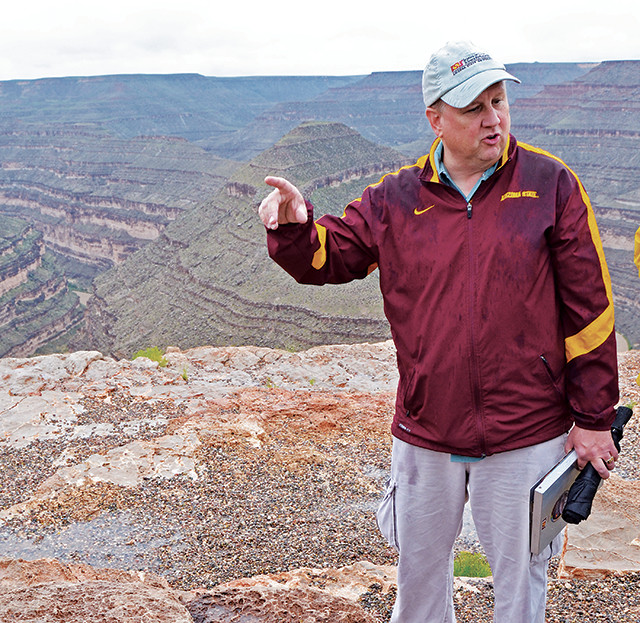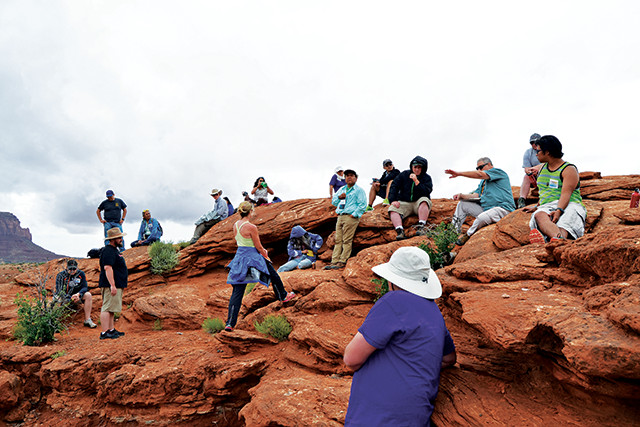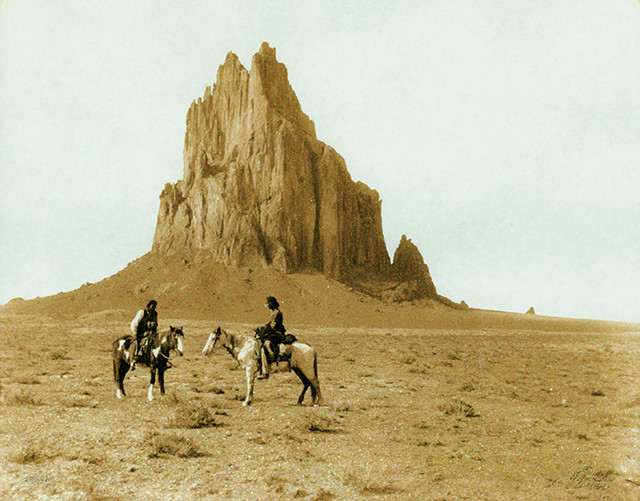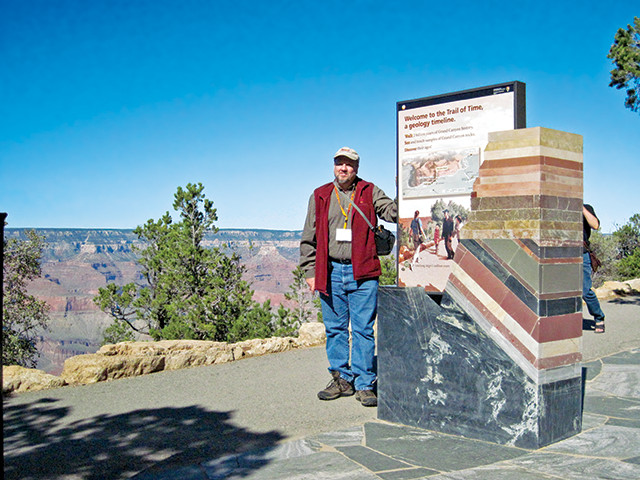
by Terri Cook Friday, April 22, 2016

Steven Semken, an associate professor of geology and education and associate director for community outreach in the School of Earth and Space Exploration at Arizona State University, discussing the geology of the Colorado Plateau above the San Juan River goosenecks in Utah. Credit: Alissa Schlecht, University of Utah.
Semken was fascinated by rocks and minerals. His father, a banker, and his mother, a municipal tax collector, loved to travel and frequently indulged their son’s yen for sparkling specimens. They also bought Semken numerous books about geography and geology, including “The Big Golden Book of Geology,” which made such an impression that his childhood copy still sits on his office shelf. Semken vividly remembers staring at the book’s picture of Ship Rock, a towering volcanic neck on the Navajo Nation in northwestern New Mexico. Little did he know that he would later spend 15 years living and teaching geology with that Ship Rock as a backdrop.
Despite Semken’s childhood fascination with minerals, he gradually lost interest in geology because it wasn’t taught at his high school. He rediscovered his passion for the field in college and graduated from MIT with a degree in earth and planetary sciences. After earning a master’s degree in geochemistry at UCLA, Semken switched gears, completing a doctorate in ceramics and materials science at MIT. In 1988, he began teaching at the Shiprock branch of Diné College, the tribal college of the Diné (Navajo) Nation, located just 15 minutes’ drive from the town’s namesake rock.
When Semken began taking Navajo students on field trips across the region, he realized that they perceived the magnificent landscapes of the Colorado Plateau differently than mainstream scientists and students. This insight led to his pioneering research in geoeducation and ethnogeology — the scientific study of human interactions with and knowledge of the earth system. He continued this work after moving in 2003 to Arizona State University (ASU), where he currently serves as an associate professor of geology and education in the School of Earth and Space Exploration.

Semken and students at a stop in Monument Valley on a field trip for teachers from Utah, as well as from the Navajo and Hopi Nations. Credit: Alissa Schlecht, University of Utah.
Recognized throughout his career for his excellence in teaching, Semken has won numerous awards, including the highest teaching award for natural sciences faculty at ASU, and has served as both a distinguished speaker and the president of the National Association of Geoscience Teachers. Semken was also elected as a fellow of the Geological Society of America in 2014. He recently spoke with EARTH about what he enjoys most about teaching in the culturally diverse Southwest, what he has learned from his students, and what he believes is the most effective tool for communicating science.
TC: Where did you grow up?
" Northern New Jersey was a great place to grow up, and also a pretty good location to be interested in earth science. We had the Appalachian Mountains not far away, and we had woods and streams near my house. When I was in fifth grade, my parents bought me a membership to a rock and mineral club. We’d go on field trips to places like Franklin [N.J.], which is a world-class locality for fluorescent minerals. My parents were not avid campers, but my dad would come along on Scout trips for my benefit, and he enjoyed it. I owe a lot to my parents because they facilitated that interest at an early age. But then I ran into the same problem we have today: I had an earth science class in junior high school, but never had it again [in high school]. When I went to MIT, I was initially a pre-med major. I wanted to be a doctor and build people like the Six Million Dollar Man. But after one semester, I knew pre-med was not for me. That’s when I rediscovered earth science.
TC: How did your interests evolve from geochemistry to ceramics to education?
" It was a circuitous path. My master’s is in isotope geochemistry. I analyzed rocks from the Mojave Desert, and in the process I learned that I love field geology and I love being in the desert. I switched to materials science because at the time I thought I needed to make that shift. Materials science is basically synthetic mineralogy and petrology, and it gave me a very different perspective about earth materials and processes. While I was in graduate school at MIT, I became interested in teaching and wound up working a lot as a teaching assistant. I really enjoyed it and wanted to do more.
TC: How did you hear about Diné College?
" In the back of my mind, I wanted to return to the Southwest and get back into field geology. I had a materials science professor at MIT who traveled extensively in the Southwest. She told me about this amazing little tribal college way out in the high desert of the Colorado Plateau with predominantly Native American students. She spoke of it in such glowing terms that I was intrigued, so I went out to visit, and I really liked the place. It was a humble school with very limited resources, but the people were wonderful, and I wound up getting a job there.
TC: What did you enjoy most about working there?
" I spent 15 years teaching in one of the most geologically amazing places in the world. Besides the Ship Rock exhumed diatreme, we had monoclines, all kinds of sedimentary rocks, Cretaceous fossils, the largest tributary of the Colorado River, and the enormous fossil fuel industry in the San Juan Basin. I taught small classes, so I could pile all my students into a van, drive for 10 minutes, and we could immerse ourselves in it.

Ship Rock, an exhumed diatreme in northwestern New Mexico, is known as Tsé Bit'a'í, or "the winged rock," in Navajo and holds cultural and religious significance for the tribe. This photo, showing two members of the Navajo Nation, was taken in 1945. Credit: Floyd Risvold, NOAA Historic Coast & Geodetic Survey Collection.
SS: I came to Shiprock, New Mexico, with the thought that I would teach the same mainstream science that I’d learned. I would take my Navajo students out to the field and go on about the geology, and I could tell that they were learning and were interested. But when I was done, they started sharing their knowledge with me. They’d tell me how they saw this land and what their names for it were, and I started to get a cross-cultural appreciation of this magnificent landscape.
TC: How did this lead to your interest in ethnogeology?
SS: After a few years, the college’s board of regents mandated that more Diné language and culture be included in the curriculum. The Navajo were concerned that the students were losing this knowledge, so the regents told the faculty that we’d have to learn about them. Since I’m not Navajo, I wasn’t sure how this would work; some of the traditional knowledge-keepers were uncertain whether they should share this much information with non-Natives. In the end, they decided it was necessary to infuse the culture. So after a number of seminars taught by tribal elders, I received a certificate in Diné educational philosophy. That’s what really jump-started my career change. I became interested in ethnogeology — the study of people’s knowledge of and interactions with earth systems, which is typically studied in the context of a given culture. My experience with Navajo ethnogeology led directly to my interest in science education research, which I was able to expand on once coming to ASU.

Semken, who taught at a tribal college for 15 years before moving to ASU, was one of the developers of the Trail of Time at Grand Canyon National Park, which teaches visitors about geologic time. Credit: Wayne Ranney Geo-Photography.
TC: What is place-based geoscience education?
SS: The sense of place is fundamental to the method; everything I do revolves around it. I learned about the significance of place working among the Diné. Indigenous people have been living in a given region for a long, long time. Their relationship to the land is best described as familial; they’re emotionally and physically connected to it. For example, the Navajo’s traditional knowledge, their ceremonies, their spirituality and their ways of life are all tied to the physical landscapes of the Colorado Plateau. When I teach, I want it to be relevant to my students. I became very interested in the idea of using this sense of place as a means of enhancing how they learn geology. Geoscientists are also very attached to places. When we study places, we get intellectually and emotionally connected to them. Sense of place is a combination of the meanings that we make in a place, plus the attachments that we form to it. I want to leverage that connection in a way that makes people more motivated to learn about the earth sciences.
TC: What was it like living on the reservation?
SS: I lived in Farmington, a border town just outside the reservation [with a large Native American population]. I was welcomed with open arms. I participated in a lot of family activities, some traditional ceremonies, and some very important moments in people’s lives. I learned some of the language. I’m not fluent in Navajo, but I wanted to use it in my teaching, so I studied it. With the help of a student and a colleague, I compiled a Navajo-English glossary of geology.
TC: Did you encounter any difficulties teaching about the origin of Earth?
SS: I’m not an expert on the Navajo culture, but my understanding of the origin of the Diné people and their land is that it is progressive. They started in one world, and when something went wrong, they ascended to another world. So their sequence of worlds was kind of an evolutionary progression. The landscape features are interpreted in terms of mythological events. Those stories tend to be allegorical; they were used to instruct people, more than to precisely interpret the origin of the landscape. I did not find it particularly difficult to reconcile traditional Diné and mainstream geoscientific interpretations of earth systems.
TC: When you can’t teach in the field, how do you bring the outdoors into the classroom at ASU?
SS: At ASU I teach regularly about the Southwest, so I use a lot of imagery, as well as rock samples and maps. In my Southwest Geology classes, one of the required purchases is the $12 geologic highway map of Arizona. Every day we open up that map and look at something different. When we’re talking about Paleozoic rocks, I open it up and ask, “Where are the Paleozoic rocks? Why are they there?” And that starts the whole discussion. I also try to leverage the students’ sense of place by using cultural references like art and music. I often begin a class by putting up a slide of the landscape we’ll be talking about, like Monument Valley, and playing a song to evoke the atmosphere and put students in a Southwestern mindset. I’m also very active in a research group at ASU that is using the best available technologies to make online and virtual teaching much more immersive. I try to not just impart information, but to help people make a personal connection to the location or the subject.
TC: What does your current research focus on?
SS: My students and I are interested in how sense of place and cultural worldview influence learning and inquiry in geoscience, and how they can foster environmental and cultural sustainability. We conduct participatory ethnogeologic research — meaning that cultural knowledge-keepers are collaborators rather than research subjects — to learn something of the sense of place and the locally situated traditional Earth knowledge of certain indigenous or historically resident groups. It’s a blend of geology and ethnography. We collaborate with diverse scholars inside and outside of ASU to apply such knowledge to the design and assessment of place-based teaching, formal and informal, which in turn is intended to be more meaningful to and inclusive of underrepresented students such as Native Americans and Latinos/Chicanos in the Southwest and Latin America. We can also apply this work to teacher professional development and to public geoscience literacy, for example, at Grand Canyon National Park. My current students are working in the Colombian Amazon and the Caribbean, and I continue to work in the Southwest U.S.
TC: What have you found to be the most effective tool for communicating science?
SS: Enthusiasm. Research shows that enthusiasm matters, and there’s plenty of qualitative evidence from student evaluations that the enthusiasm of a teacher makes a difference. Lucky for me, I’m teaching about the stuff that I love, so it’s easy to be enthusiastic. Emotion is also effective. I am not reluctant to tell my students that I do what I do because I love the Southwest. I use that four-letter word in my teaching. I love Arizona. I have a strong personal connection to this place, which motivates my scholarship and my teaching, and I hope to impart that to my students as well. I’ve had a convoluted trajectory, but it’s put me in the right place; I’m very fortunate and happy to be where I am and doing what I’m doing.
© 2008-2021. All rights reserved. Any copying, redistribution or retransmission of any of the contents of this service without the expressed written permission of the American Geosciences Institute is expressly prohibited. Click here for all copyright requests.